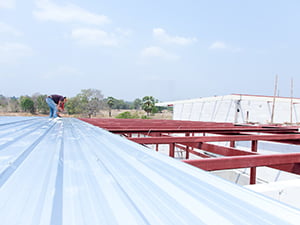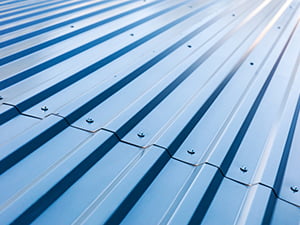
Metal roofing has gained significant popularity among homeowners and commercial property owners alike, with a standing seam metal roof emerging as a premier choice for those seeking durability and protection. These distinctive roofing systems offer numerous risk reduction benefits that make them a worthwhile investment for property owners concerned about long-term safety and structural integrity.
Eagle Eye Roofing Systems has a long history of partnering with members of the Bismarck, ND business community to improve and protect their investments. To schedule your consultation, call 701-202-7280 today.
Risk Reduction Benefits
Superior Weather Resistance
Standing seam metal roofs excel at protecting buildings from severe weather conditions. Unlike traditional asphalt shingles that can lift during high winds, the interlocking panel design of standing seam roofs creates a secure barrier that can withstand wind speeds up to 140 mph. This wind resistance significantly reduces the risk of roof damage during storms and hurricanes, preventing costly repairs and potential water intrusion.
The smooth, continuous surface of metal panels also sheds water, snow, and ice more effectively than other roofing materials. This enhanced watershed capability minimizes the chance of water pooling, which can lead to leaks and structural damage over time. Property owners in regions with heavy snowfall particularly benefit from this feature, as the slick metal surface prevents snow accumulation and the associated weight stress on the building.
Fire Safety Advantages
One of the most significant risk reduction benefits of standing seam metal roofs is their non-combustible nature. Metal roofing carries a Class A fire rating—the highest possible classification. This resistance to ignition from external sources such as windblown embers significantly reduces the risk of fire spreading to your property during wildfires or from neighboring structure fires.
Insurance companies often recognize this enhanced safety feature by offering premium discounts to properties with metal roofing, acknowledging the reduced fire risk these systems provide.
Long-Term Structural Protection
Standing seam metal roofs typically last 40-60 years with minimal maintenance, compared to the 15-20 year lifespan of traditional asphalt shingles. This longevity translates to fewer replacement cycles and reduced risk of age-related roofing failures.
The concealed fastener system used in standing seam designs eliminates exposure to UV radiation and moisture, preventing the deterioration commonly seen with exposed fastener systems. This design feature significantly reduces the risk of leaks at fastener points—a common failure point in other roofing systems.

Environmental Risk Mitigation
Modern standing seam metal roofs often incorporate cool roof technology with reflective coatings that minimize heat absorption. This feature reduces heat transfer into buildings, lowering cooling costs and decreasing the urban heat island effect in densely populated areas.
Additionally, metal roofing is 100% recyclable at the end of its service life, reducing landfill waste and associated environmental risks. Many manufacturers now use recycled content in new metal roofing, further reducing the environmental impact.
Local Standing Seam Metal Roof Experts
For Bismarck, ND property owners seeking to minimize various structural and environmental risks while maximizing protection, standing seam metal roofing represents an intelligent, forward-thinking investment that delivers decades of reliable performance and peace of mind.
To learn more ways to get the most from your commercial roofing investment, call 701-202-7280 to speak with one of our experts.
Standing Seam Metal Roof FAQs
How long do standing seam metal roofs last?
Standing seam metal roofs typically last between 40-60 years with proper installation and minimal maintenance. This lifespan is significantly longer than traditional asphalt shingles, which typically need replacement every 15-20 years. The longevity of metal roofing makes it a cost-effective choice when considering lifetime value.
Are metal roofs noisy during rain and hailstorms?
This is a common misconception. When properly installed with solid sheathing and insulation, standing seam metal roofs are no louder than other roofing materials during rainstorms. The solid roof deck and attic space provide sound buffering that minimizes noise transfer into living spaces.
Can standing seam metal roofs help reduce insurance costs?
Yes, many insurance companies offer premium discounts for homes with metal roofs due to their superior fire resistance, impact resistance, and durability against severe weather. Homeowners can often see insurance premium reductions of 15-30% after installing a standing seam metal roof. Contact your insurance provider for specific discount information.
How do standing seam metal roofs compare to other metal roofing styles?
Standing seam metal roofs offer superior weather protection compared to exposed fastener metal roofs because their fastening system is concealed beneath the raised seams. This design eliminates potential leak points where water could penetrate and prevents fastener loosening due to thermal expansion and contraction, resulting in better long-term performance and reduced maintenance needs.
Are metal roofs energy efficient?
Yes, standing seam metal roofs are highly energy efficient. They reflect solar radiation rather than absorbing it, which can reduce cooling costs by 10-25% during hot weather. Many metal roofing products meet ENERGY STAR® requirements and may qualify for energy efficiency tax credits or rebates in certain locations.
Can a standing seam metal roof be installed over existing shingles?
In many cases, standing seam metal roofing can be installed over one layer of existing asphalt shingles, eliminating the need for costly tear-off and disposal. However, this depends on local building codes, the condition of the existing roof, and structural considerations. A professional roofing contractor can assess whether your property is suitable for a metal roof overlay.
